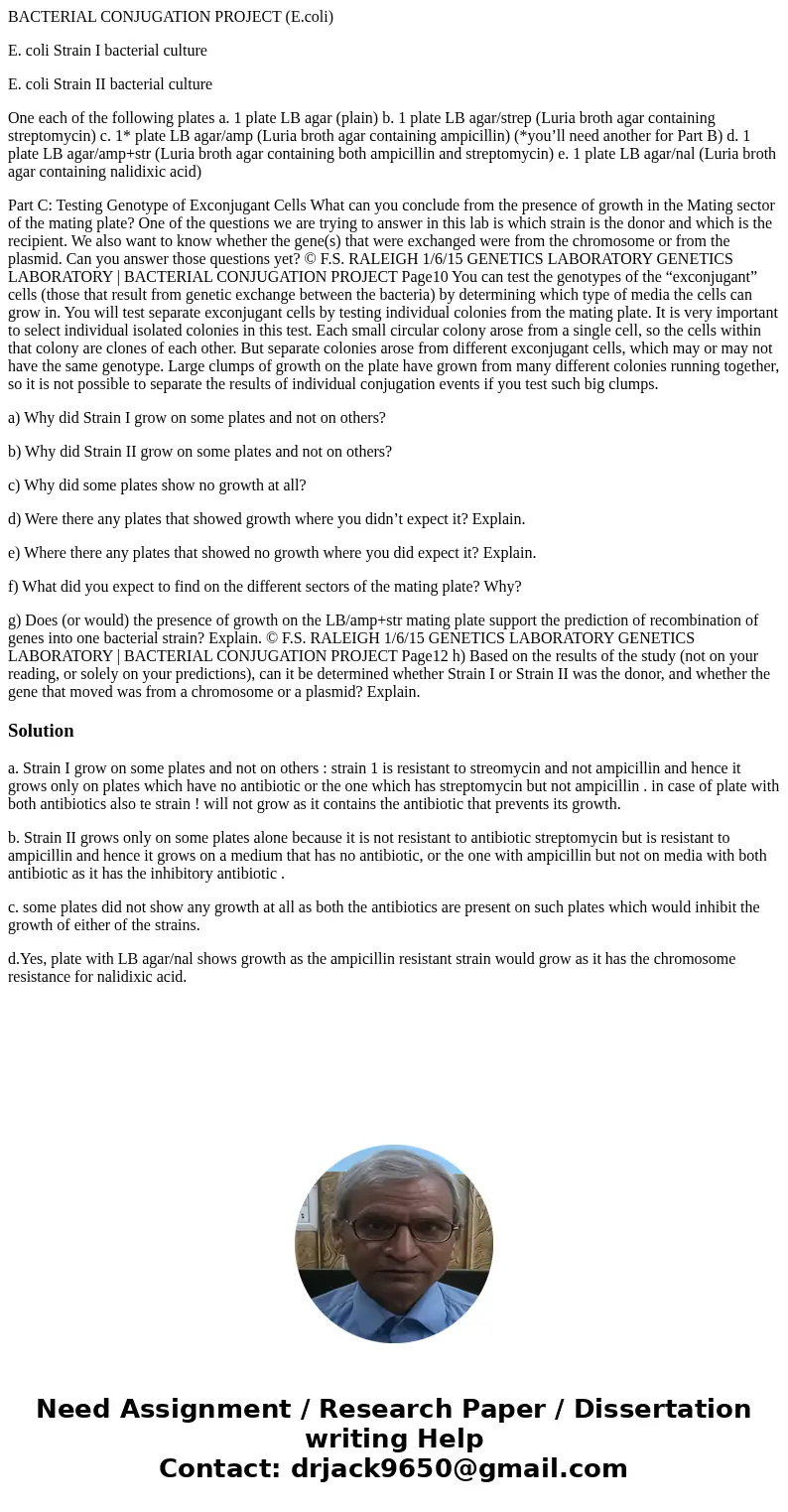BACTERIAL CONJUGATION PROJECT Ecoli E coli Strain I bacteria
BACTERIAL CONJUGATION PROJECT (E.coli)
E. coli Strain I bacterial culture
E. coli Strain II bacterial culture
One each of the following plates a. 1 plate LB agar (plain) b. 1 plate LB agar/strep (Luria broth agar containing streptomycin) c. 1* plate LB agar/amp (Luria broth agar containing ampicillin) (*you’ll need another for Part B) d. 1 plate LB agar/amp+str (Luria broth agar containing both ampicillin and streptomycin) e. 1 plate LB agar/nal (Luria broth agar containing nalidixic acid)
Part C: Testing Genotype of Exconjugant Cells What can you conclude from the presence of growth in the Mating sector of the mating plate? One of the questions we are trying to answer in this lab is which strain is the donor and which is the recipient. We also want to know whether the gene(s) that were exchanged were from the chromosome or from the plasmid. Can you answer those questions yet? © F.S. RALEIGH 1/6/15 GENETICS LABORATORY GENETICS LABORATORY | BACTERIAL CONJUGATION PROJECT Page10 You can test the genotypes of the “exconjugant” cells (those that result from genetic exchange between the bacteria) by determining which type of media the cells can grow in. You will test separate exconjugant cells by testing individual colonies from the mating plate. It is very important to select individual isolated colonies in this test. Each small circular colony arose from a single cell, so the cells within that colony are clones of each other. But separate colonies arose from different exconjugant cells, which may or may not have the same genotype. Large clumps of growth on the plate have grown from many different colonies running together, so it is not possible to separate the results of individual conjugation events if you test such big clumps.
a) Why did Strain I grow on some plates and not on others?
b) Why did Strain II grow on some plates and not on others?
c) Why did some plates show no growth at all?
d) Were there any plates that showed growth where you didn’t expect it? Explain.
e) Where there any plates that showed no growth where you did expect it? Explain.
f) What did you expect to find on the different sectors of the mating plate? Why?
g) Does (or would) the presence of growth on the LB/amp+str mating plate support the prediction of recombination of genes into one bacterial strain? Explain. © F.S. RALEIGH 1/6/15 GENETICS LABORATORY GENETICS LABORATORY | BACTERIAL CONJUGATION PROJECT Page12 h) Based on the results of the study (not on your reading, or solely on your predictions), can it be determined whether Strain I or Strain II was the donor, and whether the gene that moved was from a chromosome or a plasmid? Explain.
Solution
a. Strain I grow on some plates and not on others : strain 1 is resistant to streomycin and not ampicillin and hence it grows only on plates which have no antibiotic or the one which has streptomycin but not ampicillin . in case of plate with both antibiotics also te strain ! will not grow as it contains the antibiotic that prevents its growth.
b. Strain II grows only on some plates alone because it is not resistant to antibiotic streptomycin but is resistant to ampicillin and hence it grows on a medium that has no antibiotic, or the one with ampicillin but not on media with both antibiotic as it has the inhibitory antibiotic .
c. some plates did not show any growth at all as both the antibiotics are present on such plates which would inhibit the growth of either of the strains.
d.Yes, plate with LB agar/nal shows growth as the ampicillin resistant strain would grow as it has the chromosome resistance for nalidixic acid.

 Homework Sourse
Homework Sourse